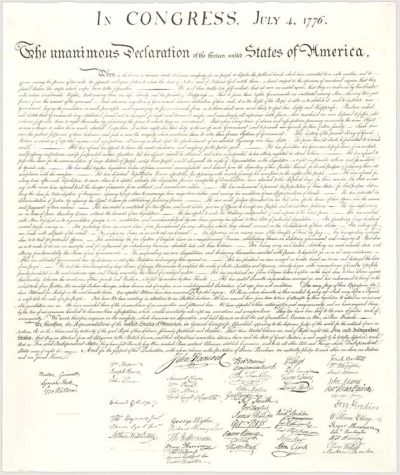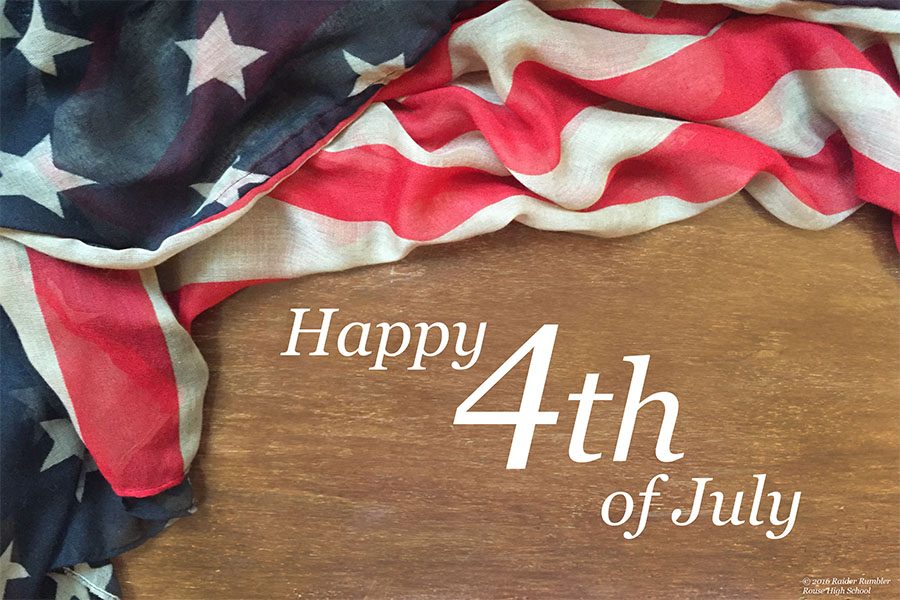Fourth of July Facts
On the 240th birthday of the United States, here are interesting facts about the Declaration of Independence and the birth of our nation
- Thomas Jefferson wrote the Declaration of Independence that was approved by the Continental Congress on July 4th, 1776. John Adams encourage the committee to select Jefferson to be the writer, even though the Virginian was initially reluctant to take on the task.
- He believed the statement needed to draw from the opinions of the American people and their Congress. The ideas and arguments he would dispel were so familiar to him he didn’t use books or pamphlets as he wrote.
- Originally, Jefferson wanted to return to Virginia to help draw up the colony’s new constitution, but leaders in the state told him to stay in Philadelphia. His drafts for a new Virginia constitution reached Williamsburg too late, and much of the work had already been completed. A preamble he had written for Virginia’s constitution went into the Declaration, a list of King George’s crimes.
- He edited as he wrote in June 1776, switching words to make the writing stronger, removing unnecessary language. “That all men are created equal and independent” was shortened to remove the independent part. “Unalienable rights” was a more concise wording than his original verbiage “rights inherent and inalienable.”
- Jefferson listed the unalienable rights of “life, liberty and the pursuit of happiness.” Men at the time often cited “life, liberty and property,” but the Virginian understood men who didn’t have property had less power. Instead he included “the pursuit of happiness,” using the phrase to emphasize the practice of happiness, not the desire for it. His use of the phrase was similar to how men spoke about pursuing law or medicine.
- John Adams and Benjamin Franklin both read drafts and made slight changes, before it was presented to Congress June 28, 1776.
- Jefferson was mortified at the changes and edits Congress made to the declaration. His “denunciations of slavery” were omitted and another section which was a sad farewell to Britain, our homeland was also removed:
“We might have been a free and a great people together; but a communication of grandeur and of freedom it seems is below their dignity. Be it so, since they will have it: The road to glory and happiness is open to us too; we will climb it in a separate state and acquiesce in the necessity which pronounces our everlasting Adieu!”
- Members of Congress did not adjust his final oath:
“And for support of this Declaration, with a firm reliance on the protection of divine Providence, we mutually pledge to each other our lives, our fortunes and our sacred honor.”
- Congress ordered a copy of Jefferson’s words to be prepared so the delegates could sign. It was read to the public outside the Philadelphia State House on July 8.
- Harvard University owns one of the few remaining copies of the Declaration on Independence. A Philadelphia printer made copies that were dispatched to newspaper, local officials and commanders in the Continental Army. Of the hundreds printed July 5, only 26 copies survive. These copies pre-date the engrossed copy that was signed in August.
- The engrossed copy, which was ordered by Congress July 19 and signed Aug. 2, 1776, is on display at the National Archives in Washington, D.C. Most historians agree that although the Declaration was adopted on July 4, 1776, it wasn’t signed until Aug. 2 (while most members signed Aug. 2, a few signed days later and two never signed it). It took two weeks for it to be written on parchment in a clear hand.
- News reached England in August when the Evening Post was the first paper to report of the American announcement, Aug. 10, 1776. Other English papers picked up the story, some creating parodies and satirical responses to Jefferson’s words and the charges against King George III.
- Two days before Jefferson’s declaration was ratified, the Continental Congress voted with no opposing votes that the American colonies were free and independent states, July 2, 1776. Only the New York delegation abstained from voting, but later voted for the resolution.
- Drafted by Jefferson, the Declaration was essentially an explanation of why Congress voted to declare independence from England.
- It took several years for the country’s leaders to make the momentous decision to declare independence from England. But continued attempts to tax the colonies strained relations and incidents like the Boston Massacre and the Boston Tea Party moved Americans closer to a patriotic decision.

- Despite declaring independence in 1776, the Revolutionary War would continue for another seven years. England finally recognized America as a free and independent state with the Treaty of Paris in 1783.
- America could not have won the Revolutionary War without the help of France. The French provided troops, ships and more than $31 million in loans. Benjamin Franklin was instrumental in negotiating with the French, convincing them to provide aid and finances, and keeping the treaty peace talks running smoothly.
- Although July 4th has been celebrated as America’s Independence Day for more than 200 years, it didn’t become a federal holiday until 1870. In 1941, Congress expanded the provision to be a paid holiday for federal employees.
Sources:
Langguth, A.J. “Patriots: The Men Who Started the American Revolution.” Simon & Schuster, New York, 1988.
“The Revolution.” The History Channel, 2006.
“July 4th.” The History Channel. http://www.history.com/topics/holidays/july-4th
“9 Things You May Not Know About the Declaration of Independence.” The History Channel. http://www.history.com/news/9-things-you-may-not-know-about-the-declaration-of-independence



